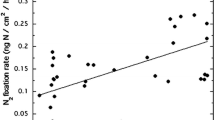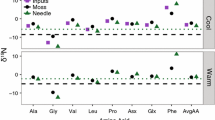Abstract
Free amino acids (FAA) constitute a significant fraction of dissolved organic nitrogen (N) in forest soils and play an important role in the N cycle of these ecosystems. However, comparatively little attention has been given to their role as labile carbon (C) substrates that might influence the metabolic status of resident microbial populations. We hypothesized that the residence time of simple C substrates, such as FAA, are mechanistically linked to the turnover of endogenous soil C pools. We tested this hypothesis across a latitudinal gradient of forested ecosystems that differ sharply with regard to climate, overstory taxon, and edaphic properties. Using a combined laboratory and field approach, we compared the turnover of isotopically labeled glycine in situ to the turnover of mineralizable soil C (Cmin) at each site. The turnover of glycine was rapid (residence times <2 h) regardless of soil type. However, across all ecosystems glycine turnover rates were strongly correlated with indices of soil organic matter quality. For example, C:N ratios for the upper soil horizons explained ~80% of the variability observed in glycine turnover, and there was a strong positive correlation between in situ glycine-C turnover and Cmin measured in the laboratory. The turnover of glycine in situ was better explained by changes in soil C availability than cross-ecosystem variation in soil temperature or concentrations of dissolved inorganic N and FAA-N. This suggests the consumption of these low-molecular-weight substrates by soil microorganisms may be governed as much by the overall decomposability of soil C as by N limitation to microbial growth.






Similar content being viewed by others
References
Alavarez R, Alavarez CR (2000) Soil organic matter pools and their association with carbon mineralization kinetics. Soil Sci Soc Am J 64:184–189
Andrade G, Mihara KL, Linderman RG, Bethlenfalvay GJ (1997) Bacteria from rhizosphere and hyphosphere soils of different arbuscular mycorrhizal fungi. Plant Soil 192:71–79
Atkin OK (1996) Reassessing the nitrogen relations of Arctic plants: a mini-review. Plant Cell Environ 19:695–704
Bardgett RD, Streeter TC, Bol R (2003) Soil microbes compete effectively with plants for organic-nitrogen inputs to temperate grasslands. Ecology 84:1277–1287
Berg B, Ekbohm G (1991) Litter mass-loss rates and decomposition patterns in some needle and leaf litter types. Long-term decomposition in a Scots pine forest. VII. Can J Bot 69:1449–1456
Berg B, Meentemeyer V (2002) Litter quality in a north European transect versus carbon storage potential. Plant Soil 242:83–92
Berthrong ST, Finzi AC (2006) Amino acid cycling in three cold-temperate forests of the Northeastern USA. Soil Biol Biochem 38:861–869
Brookes PC, Newcomb AD, Jenkinson DS (1987) Adenylate energy charge measurements in soil. Soil Biol Biochem 19:211–217
Critter SAM, Freitas SS, Airoldi CC (2004) Microcalorimetric measurements of the metabolic activity by bacteria and fungi in some Brazilian soils amended with different organic matter. Thermochimica Acta 417:275–281
De Nobli M, Contin M, Mondini C, Brookes PC (2001) Soil microbial biomass is triggered into activity by trace amounts of substrate. Soil Biol Biochem 33:1163–1170
Di HJ, Aylmore LAG, Kookana RS (1998) Degradation rates of eight pesticides in surface and subsurface soils under laboratory and field conditions. Soil Sci 163:404–411
Elliot WM, Elliot NB, Wyman RL (1993) Relative effect of litter and forest type on rate of decomposition. Am Midl Nat 129:87–95
Finzi AC, Berthrong ST (2005) The uptake of amino acids by microbes and trees in three cold-temperate forests. Ecology 86:3345–3353
Flanagan PW, Van Cleve K (1983) Nutrient cycling in relation to decomposition and organic-matter quality in taiga ecosystems. Can J Forest Resour 13:795–817
Garten CT, Hanson PJ (2006) Measured forest soil C stocks and estimated turnover along an elevation gradient. Geoderma 136:342–352
Gonod LV, Jones DL, Chenu C (2005). Sorption regulates the fate of the amino acids lysine and leucine in soil aggregates. Eur J Soil Sci 57:320–329
Gordon AM, Tallas M, Van Cleve K (1987) Soil incubations in polyethylene bags: effect of bag thickness and temperature on nitrogen transformations and CO2 permeability. Can J Soil Sci 67:65–75
Hart SC, Perry DA (1999) Transferring soils from high- to low-elevation forests increases nitrogen cycling rates: climate change implications. Glob Change Biol 5:23–32
Hobbie SE (2000) Interactions between litter lignin and soil N availability during leaf litter decomposition in a Hawaiian montane forest. Ecosystems 3:484–494
Jones DL (1999) Amino acid biodegradation and its potential effects on organic nitrogen capture by plants. Soil Biol Biochem 31:613–622
Jones DL, Kielland K (2002) Soil amino acid turnover dominates the nitrogen flux in permafrost-dominated taiga forest soils. Soil Biol Biochem 34:209–219
Jones DL, Murphy DV (2007) Microbial response time to sugar and amino acid additions to soil. Soil Biol Biochem 39:2178–2182
Jones DL, Shannon D (1999) Mineralization of amino acids applied to soils: impact of soil sieving, storage and inorganic nitrogen additions. Soil Sci Soc Am J 63:1199–1206
Jones DL, Owen AG, Farrar JL (2002) Simple method to enable the high resolution determination of total free amino acids in soil solutions and soil extracts. Soil Biol Biochem 34:1893–1902
Jones DL, Farrar JL, Newsham KK (2004) Rapid amino acid cycling in Arctic and Anarctic soils. Water Air Soil Pollut Focus 4:169–175
Jones DL, Kemmitt SJ, Wright D, Cuttle SP, Bol R, Edwards AC (2005) Rapid intrinsic rates of amino acid biodegradation in soils are unaffected by agricultural management strategy. Soil Biol Biochem 37:1267–1275
Kaye JP, Hart SC (1997) Competition for nitrogen between plants and soil microorganisms. Trends Ecol Evol 12:139–143
Kielland K (2001) Short-circuiting the nitrogen cycle: strategies of nitrogen uptake in plants from marginal ecosystems. In: Ae N, Arihara J, Okada K, Srinivasan A (eds) Plant nutrient acquisition: new perspectives. Springer-Verlag, Berlin, pp 376–398
Kielland K, Bryant JP, Ruess RW (1997) Moose herbivory and carbon turnover of early successional stands in interior Alaska. Oikos 80:25–30
Kielland K, McFarland JM, Ruess RW, Olson K (2007) Rapid cycling of organic nitrogen in taiga forest ecosystems. Ecosystems 10:360–368
Kuzyakov Y, Demin V (1998) CO2 efflux by rapid decomposition of low molecular organic substances in soils. Sci Soils 3:11–22
Kuzyakov YV, Galitsa SV (1993) Kinetics of [2-14C] glycine decomposition and its incorporation into humus fractions of Sierozem. Eurasion Soil Sci 25:39–53
Kuzyakov Y, Friedel JK, Stahr K (2000) Review of mechanisms and quantification of priming effects. Soil Biol Biochem 32:1485–1498
Lancaster VA, Keller-McNulty S (1998) A review of composite sampling methods. J Am Stat Assoc 93:1216–1230
Langley JA, Hungate BA (2003) Mycorrhizal controls on belowground litter quality. Ecology 84:2302–2312
Lipson D, Näsholm T (2001) The unexpected versatility of plants: organic nitrogen use and availability in terrestrial ecosystems. Oecologia 128:305–316
Lipson DA, Raab TK, Schmidt SK, Monson RK (1999) Variation in competitive abilities of plants and microbes for specific amino acids. Biol Fertil Soils 29:257–261
McClaugherty CA, Pastor J, Aber JD, Mellilo JM (1985) Forest litter decomposition in relation to soil N dynamics and litter quality. Ecology 66:266–275
McFarland JW, Ruess RW, Kielland K, Doyle AP (2002) Cycling dynamics of NH4 + and amino acid nitrogen in soils of a deciduous boreal forest ecosystem. Ecosystems 5:775–788
McFarland JW, Ruess R, Kielland K, Pregitzer K, Hendrick R, Allen M (in press) Cross-ecosystem comparisons of in situ plant uptake of amino acid-N and NH4 +. Ecosystems
Mondini C, Cayuela ML, Sanchez-Monedero MA, Roig A, Brookes PC (2006) Soil microbial biomass activation by trace amounts of readily available substrate. Biol Fertil Soils 42:542–549
Moorehead DL, Currie WS, Rastetter EB, Parton WJ, Harmon ME (1999) Climate and litter quality controls on decomposition: an analysis of modeling approaches. Global Biogeochem Cycles 13:575–589
Morita RY (1988) Bioavailability of energy and its relationship to growth and starvation survival in nature. Can J Microbiol 34:436–441
Näsholm T, Ekblad A, Hogberg P (1998) Boreal forest plants take up organic nitrogen. Nature 392:914–917
Näsholm T, Huss-Danell K, Högberg P (2000) Uptake of organic nitrogen by four agriculturally important plant species. Ecology 81:1155–1161
Nordin A, Schmidt IK, Shaver GR (2004) Nitrogen uptake by Arctic soil microbes and plants in relation to soil nitrogen supply. Ecology 85:955–962
Nunan N, Morgan MA, Scott J, Herlihy M (2000) Temporal changes in nitrogen mineralization, microbial biomass, respiration and protease activity in a clay loam soil under ambient temperature. Biol Environ Proc R Ir Acad 100B:107–114
Olsson PA, Baath Chalot M, RD Soderstrom B (1996a) Ectomycorrhizal mycelia reduce bacterial activity in a sandy soil. FEMS Microb Lett 21:77–86
Olsson PA, Baath E, Jakobsen I, Soderstrom B (1996b) Soil bacteria respond to presence of roots but not to mycelium of arbuscular mycorrhizal fungi. Soil Biol Biochem 28:463–470
Pregitzer KS, DeForest JA, Burton AJ, Allen MF, Ruess RW, Hendrick RL (2002) Fine root architecture of nine North American trees. Ecol Monogr 72:293–309
Rothstein DE (2009) Soil amino acid availability across a temperate-forest fertility gradient. Biogeochemistry 92:201–215
Schimel JP, Chapin FS III (1996) Tundra plant uptake of amino acid and NH4 + nitrogen in situ: plants compete well for amino acid N. Ecology 77:2142–2147
Schmidt S, Stewart GR (1999) Glycine metabolism by plant roots and its occurrence in Australian plant communities. Aust J Plant Physiol 26:253–264
Treseder KK (2008) Nitrogen additions and microbial biomass: a meta-analysis of ecosystem studies. Ecol Lett 11:1111–1120
Viereck LA, Dyrness CT, Foote MJ (1993) An overview of the vegetation and soils of the floodplain ecosystems of the Tanana River, interior Alaska. Can J For Res 23:889–898
Vinolas LC, Vallejo VR, Jones DL (2001a) Control of amino acid mineralization and microbial metabolism by temperature. Soil Biol Biochem 33:1137–1140
Vinolas LC, Healey JR, Jones DL (2001b) Kinetics of soil microbial uptake of free amino acids. Biol Fertil Soils 33:67–74
Waldrop MP, Firestone MK (2004) Microbial community utilization of recalcitrant and simple carbon compounds: impact of oak-woodland plant communities. Oecologia 138:275–284
Zak DR, Tilman D, Parmenter RR, Rice CW, Fisher FM, Vose J, Milchunas D, Martin CW (1994) Plant production and soil microorganisms in late-successional ecosystems: a continental-scale study. Ecology 75:2333–2347
Acknowledgements
Greg Mauer, Jennifer Mitchell, and Jason Schneider provided invaluable assistance in the field. We also wish to thank Lee Ogden of the Warnell School of Forest Resources at the University of Georgia, and Dr. Andrew Burton of the School of Forest Resources & Environmental Sciences at Michigan Technological University, for their extraordinary logistical support during our field efforts. Dr. Adrien C. Finzi, Dr. Stephen C. Hart and Dr. F. Stuart ‘Terry’ Chapin III and two anonymous reviewers greatly improved the quality of this manuscript with their comments. This research was supported through grants from the University of Alaska’s Center for Global Change, the National Science Foundation’s Ecosystem program, and the Bonanza Creek LTER program.
Author information
Authors and Affiliations
Corresponding author
Rights and permissions
About this article
Cite this article
McFarland, J.W., Ruess, R.W., Kielland, K. et al. Glycine mineralization in situ closely correlates with soil carbon availability across six North American forest ecosystems. Biogeochemistry 99, 175–191 (2010). https://doi.org/10.1007/s10533-009-9400-2
Received:
Accepted:
Published:
Issue Date:
DOI: https://doi.org/10.1007/s10533-009-9400-2




